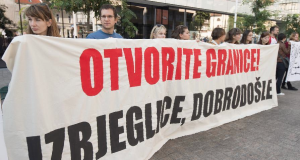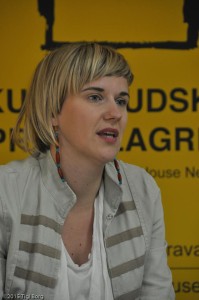
What specific challenges has the position of your country on the refugee corridor between the Mediterranean and Western Europe brought in the past months, in relation to numbers of refugees transiting (issues such as asylum laws, transport, border control) ?
Croatia’s position in the corridor is challenging for the society and its institutions since the issue of migration and asylum was ignored for years. Formally laws have been declared, but in practice they were not implemented. Migration has become Croatia’s priority over night. The state was surprised when the corridor route entered Croatia and a response was created within a few days. In the first couple of days people were sleeping in the fields – until the Ministry of Interior opened the temporary reception centre Opatovac. However, conditions in that center are quite poor. The numbers are challenging: 200,000 people passing through Croatia, a very small number are seeking asylum (around 30), with the reception capacity in tents for 5,000 persons, opening new capacities in Slavonski Brod, etc. And this entire situation is taking place during an election campaign. We saw people walking for 17km to reach registration areas because there were no buses to transport them; and we thought we will not see that scenario again – but it is happening again since Slovenia is not receiving as many people as Hungary did.
Croatia’s Minister of External Affairs has stated that if Austria and Slovenia close their borders, Croatia will do the same. That will create a situation of building up walls and supporting the idea of Fortress Europe. Croatia is following EU steps and politics, which is not going in favour of refugees.
How have the state and the police responded to the refugee crisis? How has your country been involved in the FRONTEX and EU border regime prior to the crisis and what has changed since?
The response of the Ministry of Interior is connected to its agreements with other member states in the region. In the first few weeks, Croatia managed to create a corridor to Europe towards Hungary – trains and buses were organized at several border crossings. When Hungary closed its borders, the corridor was transferred to border crossings with Slovenia. Slovenia is not accepting the same numbers as Hungary did, which interrupted the tempo that was created, so now there is a problem on the streets of Croatia: fences on the borders, fear in the eyes of refugees and locals.
Croatia’s involvement in FRONTEX has been made through support of the rescue operations in the Meditteranean Sea – to Italy.
Where is the support for the refugees coming from in your country? Which specific organizations (governmental or NGOs), networks of activists and volunteers are involved? Do you cooperate with regional actors and on what levels for which purposes?
Support for refugees is coming from different groups. The Ministry of Interior (MoI) is in charge of coordinating refugee transportation. The Croatian Red Cross is working closely with the MoI and is coordinating other NGO’s that have been working with refugees for years now – the Centre for Peace Studies, the Croatian Law Centre, the Youth Group ‘Dunav,’ the Jesuit Refugee Service, the Society for Psychological Support, the Volunteer Centre Osijek. Furthermore, there are also international organizations present: UNHCR, UNICEF, IOM, MAGNA. Greenpeace and Doctors without borders were also present, but no longer due to other missions they have. Outside the camp, there have been many international independent volunteers and groups supporting refugees. Aside from this, some local Croatian groups showed high levels of support and solidarity – when they encountered refugees in their local community, they immediately organized humanitarian aid: Harmica – REMAR, Ivan Perkovac group; Bapska – a women’s organization; and probably some more that I am not aware of.
The Centre for Peace Studies is cooperating with regional actors – civil society organizations, international organizations and other MS; on the advocacy level: demanding to keep the borders open, create a safe corridor for refugees and create urgent measures of protection. We consider that mechanisms of temporary protections should have been activated, but that the member states should also consider uniform asylum status for entire EU with special focus on integration policies that are effective, sustainable and long-term.
What is the response of the local population? What are the main arguments against or in support of the refugees which you have heard?
As mentioned before, some local groups acted immediately as they encountered refugees in their local communities. Locals have showed solidarity toward refugees, as many of them have been refugees themselves so the humanitarian approach was right. In the beginning of the humanitarian crisis in Croatia – there were few attempts at organizing anti-immigration protests stating that all refugees are terrorists. But those were cancelled. Smaller group of individuals did gather one Saturday in Zagreb protesting against refugees.
However, Croatia still needs to receive 1,650 persons from the reallocation and resettlement agreement within a period of 2 years. Croatia does have experience of receiving refugees from the region. This time refugees come from culturally diverse areas and existing institutions will need to prepare their employees, create programs for integration, but also prepare local communities in living with refugees – to prevent misunderstandings.
The Centre for Peace Studies conducted research on the issue of xenophobia two years ago, and the results showed that people who are against refugees mostly approach the issue from two directions: (1) that refugees will take away jobs from Croatians and (2) that they will not perceive theirs interests for Croatia as primary, but maintain interest in the country they ran away from. In these times most stereotypes are: they are economic migrants, they have money and smart-phones, why are they coming in Croatia that is poor, etc. It is necessary to prepare communities for the current issues and tackle the issue of racism and xenophobia – first on an institutional level and then within local communities.
How do you see the situation evolving in the next months?
The situation is chaotic. EU member states are responding too late with the explanation that they were not expecting it. These statements are quite unreal and spoiled – taking into consideration that the same situations was happening in countries like Malta, Italy and Greece who were asking for support. The same situation was even happening in regional countries (Serbia, Macedonia), but until it doesn’t happened in your own backyard it is like it didn’t happened at all.
What I see now is a domino effect response – if Austria closes the border, then Slovenia will do it, then Croatia will do it. This will happen at a certain point since Europe is going towards a solution of giving money to Turkey to keep people outside the EU, externalizing access to asylum, and creating hot-spots.
Many member states who were masters of the reception and integration system – cannot handle the situation any longer. They are improvising and are frustrated that they have to improvise since they are going below their standards.
My opinion is that member states that do not have high acceptance rates – have to rebuild their integration policies and prepare communities for life within intercultural societies. There are policies and practices that can be applicable and from which MS can learn from. The other option is radicalization, which I am not in favour – and that will only bring us one step backwards.
Within activists and CSO’s I see the spirit of a social movement that will have a big importance for the current situation. We all have to be a part of it, since it will affect our future.


